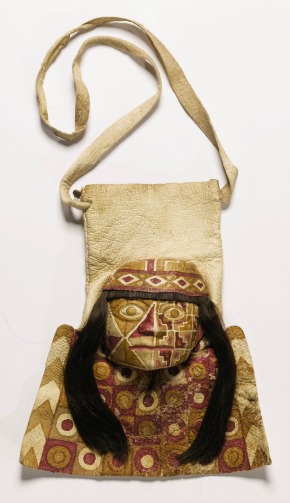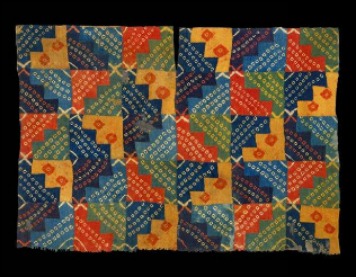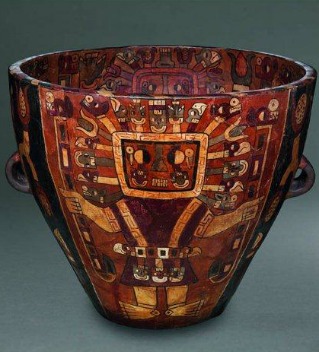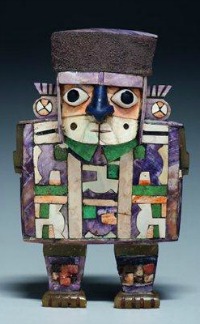 Last spring, when I was reporting an article about acquisitions endowments, I was seduced by a little guy who had been purchased not too long before by the Cleveland Museum of Art (which has one of the biggest purchase funds among U.S. museums).  Made sometime between 600 and 1000 AD, and pictured at left, he came from a culture — the Wari of Peru — that I knew nothing about. And I knew I was not alone.
Last spring, when I was reporting an article about acquisitions endowments, I was seduced by a little guy who had been purchased not too long before by the Cleveland Museum of Art (which has one of the biggest purchase funds among U.S. museums).  Made sometime between 600 and 1000 AD, and pictured at left, he came from a culture — the Wari of Peru — that I knew nothing about. And I knew I was not alone.
Although I didn’t mention it at the time, I also knew that this painted lifelike human face on a hide bag, used to stash coca leaves, was to be featured in an exhibition this fall. And I watched for it. That 150-object show, Wari: Lords of the Ancient Andes, curated by Susan E. Bergh, will open on Sunday at the Cleveland museum. It’s the first exhibition devoted to the Wari in the U.S., and so will introduce many of us to this culture (after Cleveland, it will travel to the Fort Lauderdale Museum of Art and the Kimbell Art Museum).
We don’t know much about the Wari. That’s because, as I write in an article to be published in tomorrow’s Wall Street Journal, the Wari had no written language (of course, neither did the Inca) and because they were almost entirely left out of colonial accounts (which the Inca were not).
 But the Wari aesthetic is warmer, more human, it seemed to me when I looked at the beautiful catalogue published for the show. Bergh feels similarly: Inca material is more geometric, abstract, muted and simple, compared to the warmer colors and figurative nature of the Wari works. You can’t take that too far — as I learned from her — the Wari believed in human sacrifice, as did many other early cultures. (But less so, perhaps, than the Aztecs and the Incas.) Still, one of the Wari characters is called the sacrificer.
But the Wari aesthetic is warmer, more human, it seemed to me when I looked at the beautiful catalogue published for the show. Bergh feels similarly: Inca material is more geometric, abstract, muted and simple, compared to the warmer colors and figurative nature of the Wari works. You can’t take that too far — as I learned from her — the Wari believed in human sacrifice, as did many other early cultures. (But less so, perhaps, than the Aztecs and the Incas.) Still, one of the Wari characters is called the sacrificer.
This is the kind of exhibition that I believe can attract those often-elusive wider audiences everyone wants — they don’t have to be like the Princess Diana thing I mentioned yesterday. In fact, as I usually do when I arrive somewhere to report an article, I started talking about the museum on my way in from the airport last week: my driver hadn’t been to it in years. He didn’t know it was free, and had not even heard of the museum’s ongoing expansion, whose new atrium opened this fall to wide publicity. But when I told him about the Wari, he said he wanted to go (and, btw, that that plan would please his wife!). I do not think he was mollifying me — when I got out of his car, he asked me again when the exhibition opened.
The Cleveland museum has been thinking about marketing, of course. One tangible piece of evidence: when it announced the acquisition (two, really — there’s a ceramic piece bought at the same time), the exhibit was called Wari: Realm of the Condor. The current title has more allure, I agree.
 Cleveland received money from the National Endowment for the Humanities to help fund this exhibition, which is also telling. It’s an endorsement of its scholarly nature.
Cleveland received money from the National Endowment for the Humanities to help fund this exhibition, which is also telling. It’s an endorsement of its scholarly nature.
And as I mention at the end of my article, Wari: Lords of the Ancient Andes is intended to provoke more research and study. Cleveland is not hosting a symposium during the show (its educators’ guide, posted on the museum’s website, is worth a look, though) — but maybe someone else will jump in.
Eric Lee, director at the Kimbell — could that be your museum?
Meantime, I’m going to post picture of a few objects you’ll see in the exhibit here as an enticement.
 UPDATE: Eric Lee has written to me — the Kimbell will indeed host a symposium. Here’s what he said:
UPDATE: Eric Lee has written to me — the Kimbell will indeed host a symposium. Here’s what he said:
yes, the Kimbell is planing to host a half-day symposium on Saturday, June 15, 2013, during the exhibition’s opening weekend, from 10 a.m. to 1 p.m. We are inviting three leading experts in the field to discuss current research and new discoveries. The speakers have not yet been confirmed, but we hope to announce the topics and speakers early next year.
By the way, he added:
ten years ago the Kimbell acquired the Wari figure pendant (image attached) featured on the back cover of the exhibition catalogue. It is only a couple of inches high, but has enormous presence and is a favorite of our visitors.
I agree. I saw the pendant in Cleveland, and now I have posted it here, at right. You can see why it’s a favorite.
Photo Credits: Courtesy of the Cleveland Art Museum
Â
